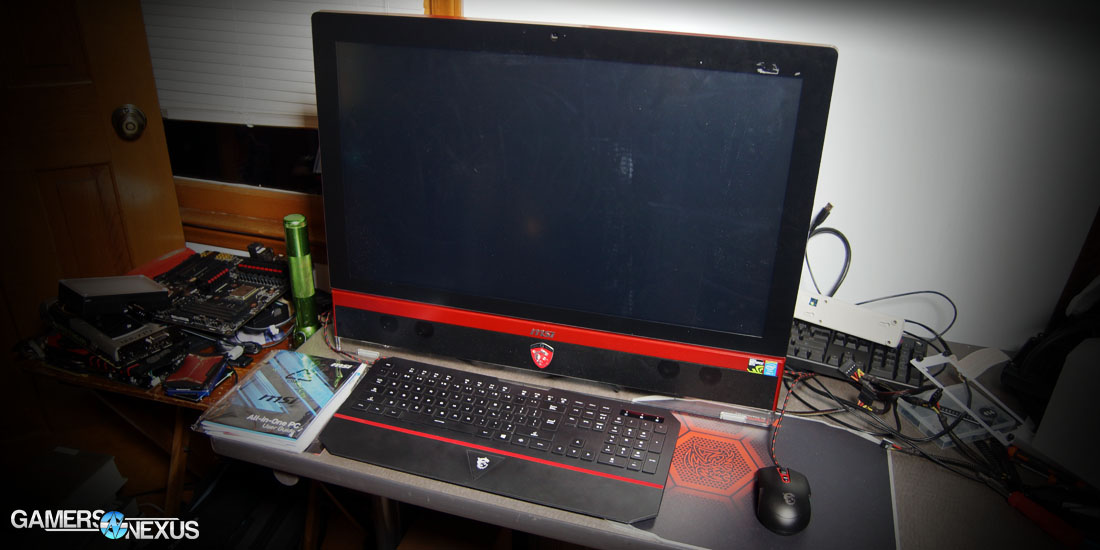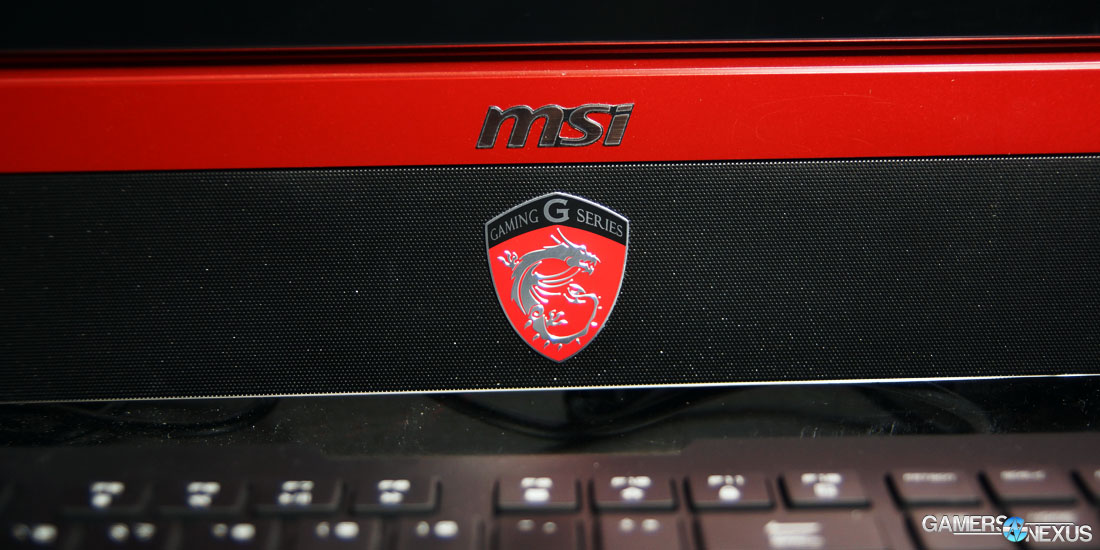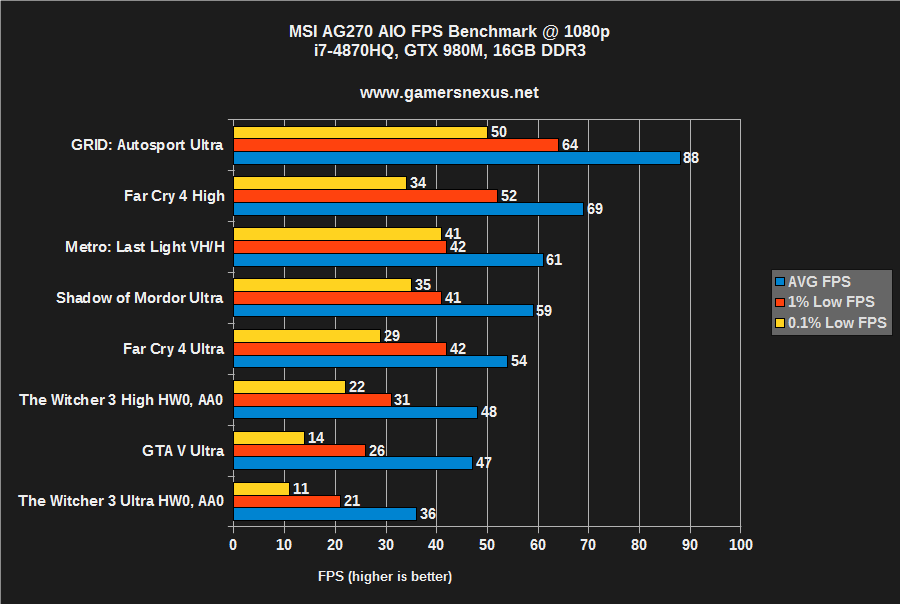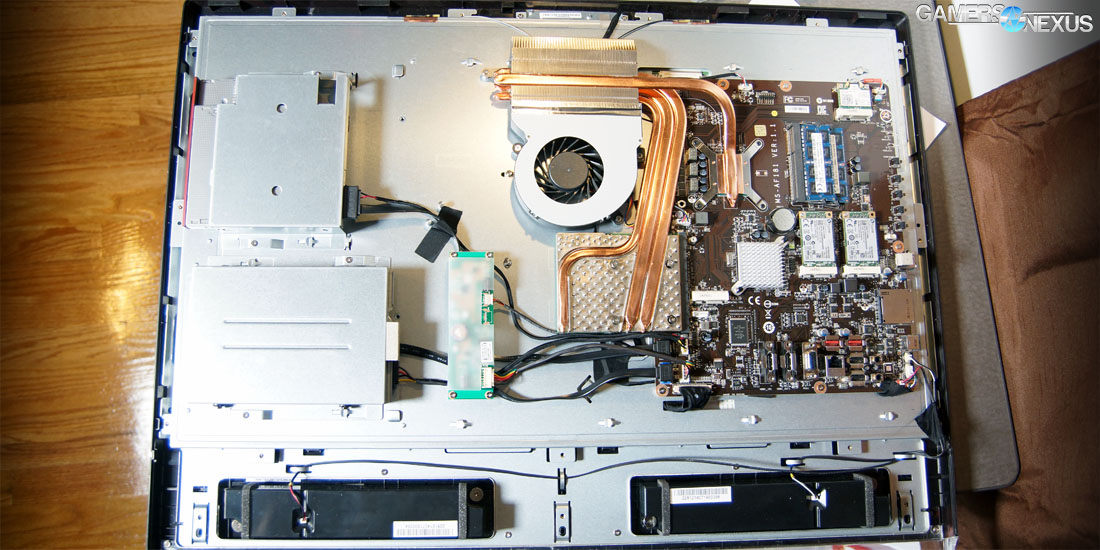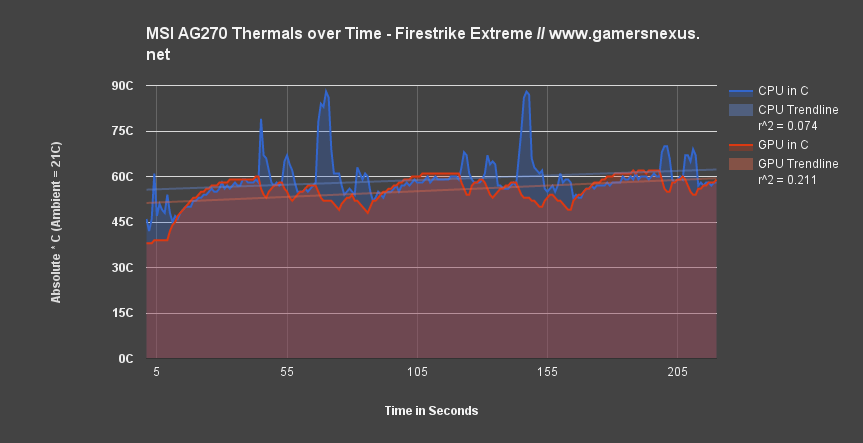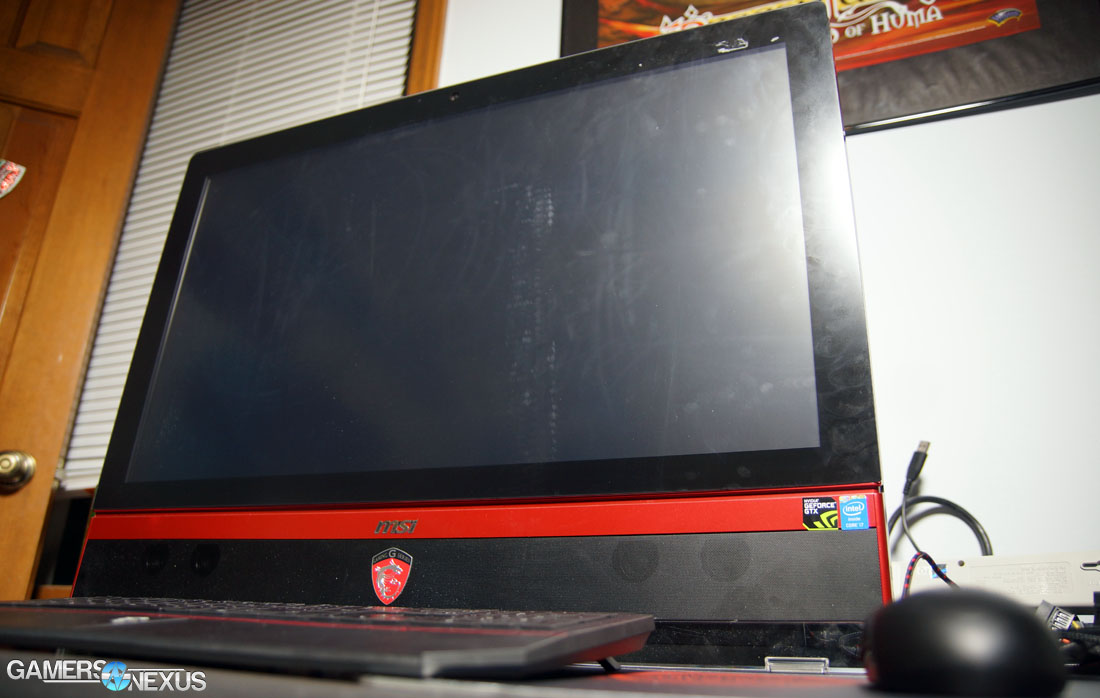AIO computers are a strange thing to us. As system builders, they often feel like artifacts from a distant, alien world. But they've improved in their gaming efficacy of late, and for that, it's worth a thorough review of one of the specs-leading gaming AIOs.
MSI's AG270 AIO computer is equipped with an nVidia GTX 980M and i7-4870HQ CPU, both high-end laptop components, and offers a 27” touchscreen with built-in speakers. The unit is a true all-in-one in this regard, but it does include more standard keyboard / mouse input options in the box. Most importantly, the AG270 is a $2700 gaming computer, making it somewhat intimidatingly priced.
Before jumping into the MSI AG270 all-in-one review and benchmarks, let's look over the system's core specs and features.
MSI AG270 Specs
| Model | MSI AIO AG270 2QE-037US |
| CPU | Core i7-4870HQ 2.5GHz CPU |
| RAM | 16GB DDR3-1600 |
| GPU | GTX 980M 8GB |
| Storage | 2x 128GB M6M SSD 1x 2TB Barracuda 7200RPM HDD |
| NIC | Killer Gigabit Ethernet AC Wireless |
| Optical | BD Burner |
| Display | 27" 1920x1080 10pt Touchscreen |
| PSU | 230W AC Drop |
| Peripherals | MSI DS4100 Keyboard MSI DS100 Mouse Built-in speakers |
| OS | Windows 8.1 64-bit |
| Price | $2700 |
Nearly all modern AIO systems are built using laptop components. This permits smaller form factor and better thermal control in a cramped space. In the case of the AG270, the unit is fitted with an nVidia GTX 980M mobile GPU – the same GPU in the CyberPower and Origin laptops we recently reviewed – and hosts an i7-4870HQ CPU. The 4870HQ is among Intel's top-performing mobile Haswell CPUs and is fitted with an Iris Pro 5200 IGP for low TDP graphics processing. Because the MSI unit isn't reliant upon battery power, as a laptop would be, the Iris Pro IGP will go largely unused except in some accelerated applications. The system's also got 16GB of DDR3-1600 memory installed.
A lower-end 4710HQ version of the system retails for around $2500, with the $2000 model slashing the touchscreen and dual SSDs.
Storage of our model sees the utilization of RAID two 128GB Plextor M6M mSATA SSDs for a total usable size of ~240GB. A standalone mSATA M6M is advertised and rated for ~520MB/s sequential read and ~440MB/s sequential write, with 4K IOPS ratings upwards of an impressive 94K & 80K (read/write). The RAID configuration allows even greater speeds than these. A 2TB Seagate Barracuda HDD offers storage space at 7200RPM, making for plenty of media and gaming storage. We generally don't favor Seagate for its lower end consumer HDDs due to their failure rates, but the inclusion does reduce cost over similar WD alternatives.
Wireless is built-in using an Intel dual-band AC 7260 chip – the same as you'd find on a laptop or some high-end desktop motherboards. Wireless AC offers greater throughput for users fortunate enough to live in an area with gigabit internet.
Use Cases, Pros, & Cons of an AIO Computer
As I see them, AIO systems would primarily be found in living rooms or common areas, effectively serving as family or visitor machines. Because an AIO mounts its hardware to the back of the display, it's slightly more space efficient than an SFF system + monitor setup and sleeker. It's not more “portable” by any means, though, evidenced by the unwieldy dimensions and ~30 pound weight.
Unimportant to me, but definitely of value to others, is the aesthetic factor of AIO computers. An AIO can be presented in a somewhat modern and clean fashion, limiting behind-the-system cable clutter and eliminating the need for an enclosure with system components. Although a silent SFF system could easily be built – even using some of MSI's own components, like the Gaming 4G cards – AIOs offer effective silence (think: laptop) in a pre-built fashion.
That's about all there is to it – presentation and compact design.
The list of cons sort of fluctuates dependent upon what type of user the buyer is. An AIO is expensive – that's number one. You're paying for the look, the compact design, and the form factor. An AIO might also include features which are undesired or unneeded for the user; the touchscreen, for instance, seems an odd choice for a gaming box with a 980M. It'd make more sense equipped with something more targeted toward casual users, as very few “core” games (demanding of a 980M) would be enjoyable with a touchscreen. That's a big added cost that doesn't necessarily get used. This is countered by the $2000 alternative, but then we lose other features – like the higher-end CPU and RAID SSDs.
Other cons would include aging of the box: If one component goes, unless you're the type to source parts and fix it, the whole thing goes – monitor and all.
The AG270's Touchscreen, Keyboard, & Mouse Input
As above, the inclusion of a touchscreen on a gaming-targeted device is interesting. The AIO ships with painting software that goes well with the touchscreen and makes for a bit of fun, but certainly isn't the pressure-sensitive professional quality that would be offered by a proper artist's tablet. It comes off more as a novelty that grows old (and frustrating) within the span of an hour. We also found it incredibly tiring to use the touchscreen functionality from a seated position; the positioning of the display is not inherently conducive to extended touch use, leading to tired arms after a few minutes of waving them around in the air.
As for actual input detection, the unit functions fine. It's comparable to a $500 Acer 10-point touchscreen in responsiveness. The display can detect ten points of input simultaneously and coincides with the push for touch-friendly operating systems (Windows 8.1 pre-installed), but again, I just don't see it getting used the majority of the time. Unless working with an application or game that specifically designs for touch input, it becomes more of a burden than productivity boon to use touch. It's a good arm workout, though.
MSI has elected to include a fallback in the form of traditional keyboard / mouse input, thankfully, but it leaves a lot to be desired – like a mouse and keyboard. Over the period of testing, we've had two sets of hands on the AG270 for thermal and FPS benchmarking; in both instances, we elected to replace the included keyboard and mouse with items that were more precision-tuned and less hindering to production.
Starting with the mouse, MSI's DS100 gaming mouse offered terribly inaccurate input, to the point that it was tracking on its own (flickering, exhibiting spurious motion) when no hands were laid upon it. The touchscreen was originally suspect for the 'teleporting' cursor actions, but we later discovered that the mouse was responsible for the undesirable input. Replacing this would be a priority.
The keyboard doesn't have to be mechanical to be good, but MSI's DS4100 “Interceptor” keyboard isn't one of those good non-mechanical boards. The keyboard more closely resembles laptop input, except somewhat inhibited; poor layout plagues the keyboard – like the size of the return key and position of the forward backslash – and actuation makes for uncomfortable and awkward typing. Using our test Logitech G910 or Tt eSports Poseidon (mechanical boards), I'm able to produce a words-per-minute rate of ~120WPM. Using a membrane Logitech G11, it's about ~108-112WPM. On the DS4100, my WPM plummets to about 70 due to poor responsiveness of keys and the heavy load placed on 'backspace.'
It's incredibly irritating to use and would be better replaced by decade-old Microsoft or Dell keyboards, sadly.
This isn't a big deal, but it just feels like wasted allocation of resources. If I'm spending $2700 with the promise of an included mouse and keyboard, they should be at least passable for use; if they're not, don't include them – I'd rather just reduce MSRP than spend more money on components that end up in the trash.
MSI AG270 Audio & Volume
Volume levels are always of note when working with laptop components. With an AIO, part of the “sell” is the reduction of cabling and other desktop clutter – that'd include speakers. MSI's AG270 offers powerfully loud audio at its highest volume level and likely won't be “too quiet” for anyone. The output errs on the tinny side due to its lack of any form of subwoofer, but it's more or less “fine.”
If MSI were to make improvements for a next-gen version of this product, I'd suggest investigating the inclusion of a woofer in the rear side of the system, similar to what's done on some MSI laptops. Not a big thing, but worth noting for growth.
Continue to page 2 for gaming benchmarks, thermals, and the conclusion.
Testing Methodology
Our AIO test methodology parallels what we employ in GPU and laptop reviews. We tested using Metro: Last Light's benchmark on high & very high settings, GRID: Autosport on ultra (4xMSAA), Shadow of Mordor on ultra, Far Cry 4 on ultra, The Witcher 3 with Ultra and High (HairWorks off, AA off, SSAO), GTA V on Ultra, and a few other settings. Synthetic testing was performed using 3DMark. Thermal data was logged during the 3DMark Firestrike Extreme test, stressing the GPU at 100% load for 20 minutes.
All FPS tests were performed three times for parity. FRAPS was used to log FPS data in 30-second increments, then that data was dissected with a spreadsheet.
As a reminder, our benchmark shows these items:
- Average FPS: The time-averaged frames per second of gameplay.
- 1% Low FPS: The FPS displayed 1% of the time. This is a better indicator than "minimum" because it is not an outlier and is more likely to jar the user.
- 0.1% Low FPS: Same as above, except 0.1% of the time.
MSI AG270 980M Gaming Benchmarks
Benchmarking our usual suite of games, we looked at MSI's gaming performance with the AG270 + 980M. Framerate output was tested in The Witcher 3, GTA V, GRID: Autosport (a highly-optimized bench title), Far Cry 4, Shadow of Mordor, and Metro: Last Light. We modulated settings slightly on some titles, but mostly stuck to high or ultra settings given the relative power of the GTX 980M.
It is worth noting that, unlike all previous 980M tests we've done, there is no reliance on battery here. This means that performance remains fairly constant throughout testing and won't throttle for power. When running on battery, a laptop + 980M combo will throttle FPS to 30 to reduce power consumption. This is not the case when connected to an AC drop.
The results are as expected for a 980M and high-end CPU. The AG270 pushes right around 60FPS for most titles we tested when at ultra or high settings, with The Witcher 3 and GTA V being the only true low performers. Dropping the Witcher 3 to lower foliage detail (using our optimization guide) would give the FPS the bump needed for better fluidity; GTA V could also be dropped, per our optimization guide.
Performance overall allows for high to ultra settings on most modern titles with ~60+ FPS.
MSI AG270 Thermal Benchmarks
Thermals were tested using Firestrike Extreme, 3DMark's benchmarking software that renders graphics to 1440p resolution using scaling, and analyzed with AIDA64. We've published a table of temperature rise and fall throughout the test period.
The i7-4870HQ and GTX 980M do well to regulate their thermals. The above chart shows absolute measurements (delta would subtract Ambient T of 21C), with the CPU hitting ~90C absolute (68-69C delta T) on a few occasions. Within seconds of each spike, the CPU drops to more permissible temperatures. A trendline shows that the CPU remains in the 60C range average, with the GPU temperature in the 50s to 60C.
These aren't hot enough to incinerate the components, and that's all we can really ask with laptop hardware. Thermals are well regulated when they do spike to dangerous levels and are immediately dropped, likely thanks to the massive heatsink and large surface area for dissipation at the back of the display. The AG270 uses a set of 3x10mm heatpipes and 1x6mm (could be 8) heatpipe to keep the system cool, all routed to large, aluminum heatsinks mounted atop the microprocessors. This cooling setup is a slight step above what's found in a lot of laptops, but corresponds with the more standard size motherboard given the generally large amount of real estate.
Conclusion
MSI's AG270 offers superior gaming performance and high framerates with near-max settings. There's no denying that the unit is at the top of the portables and AIO class when it comes to gaming – a given when equipping a system with the latest i7 and GTX 980M processors – and basic production applications will similarly excel on the AG270. Photoshop, for instance, is capable of utilizing both the Iris Pro and CUDA nVidia cores present on the AIO system. Thermal performance is impressive when compared to actual laptops using similar components; the system is able to keep temps largely in the ~60C range (CPU) and ~50-60C range (GPU) under 100% load, which convert to Delta T over Ambient values of 39C and 29-39C, respectively. The larger surface area for components affords this advantage over laptops, allowing the system the space required to implement massive 10mm heatpipes and an effective cooling solution.
A few small points of improvement, more for MSI's sake than anyone else's, would be to add notches in the acrylic baseplate for cleaner cable routing. We'd also be curious to see how a sub-woofer would do when installed in a fashion resembling what some laptops now do. Offering an SSD-equipped model sans touchscreen would also be appreciated, as the SSD is a near-necessity at that price, but the touchscreen is something most gamers could live without. Most importantly, any keyboard / mouse combo would be better than the present setup. I also found the viewing angles of the stand and glossiness of the display to be a little bit of a struggle at times, but that's harder to resolve with an AIO.
In a vacuum, looking strictly at thermals and gaming output, the AG270 is more than acceptable for most modern games. It's when we introduce price and competing products that the conclusion gets muddied.
A $2700 price-tag is a rough buy. It's not unfair – a GTX 980M-equipped laptop would cost about $2000 and a 27” touchscreen would be $500, so the pricing isn't necessarily off-base for the hardware offered. That doesn't make it less intimidating, though, and the fact that the AIO is a desktop, unlike its actual laptop counterparts, means that we've got to look at competing desktop devices. Excluding system builders from the equation, purchasing a prebuilt machine from an SI like CyberPower or iBUYPOWER would land the build cost at around ~$1700 while offering superior components. We'd then have to factor-in the purchase of a monitor; imagine for a moment that we definitely want a 27” touchscreen display, as the AG270 offers – that's another $500 from Acer, so now we're at $2200 for a similarly powered setup. Dumping the touchscreen functionality makes things more affordable, and if size is a concern, the system could be configured in an SFF box.
For a great deal of our readership, I should imagine that the price advantage of a two-box system would be preferable to an all-in-one assemblage, which primarily boasts cleanliness of design. An SFF setup isn't good enough for some buyers, though, and we recognize that. In such instances, the AG270 serves as a high-powered solution for the living room and we feel confident in its thermal dissipation abilities – a critical aspect for any mobile-equivalent build. The performance is on-par with running modern games like the Witcher 3 and GTA V at moderately high settings when tuned.
- Steve “Lelldorianx” Burke.
